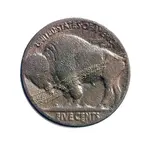After reading through this thread I decided to do a little research of my own. There is a difference of opinion on how coins end up where they do and I'm not busting anyone's chops or trying to start a fight. My intent is to provide information on the physics and geology of soil to the OP and not take sides or disprove anyone.
I will post the links where I gathered the information at the end of this post.
Here is where my opinion ends and the science begins: 
Soils build downward they do not accumulate upward. Soil itself is very complex. It would be very wrong to think of soils as just a collection of fine mineral particles. Soil also contains air, water, dead organic matter, and various types of living organisms. The formation of a soil is influenced by organisms, climate, topography, parent material, and time.
Additions
Organic matter that accumulates in soils includes the remains of organisms, plants and animals, but mostly plants. When plant debris falls onto the soil surface it may accumulate to form a surface litter layer or it may be mixed into the surface mineral horizons. Organic matter also may be added directly to the soil from roots and by animals.
Translocations
Most soils swell when wet and shrink as they dry. In some soils the magnitude of change with wetting and drying may be quite small, whereas in other soils it may be fairly large, for instance deep, wide cracks may extend about 1 m (3.3 ft) into some soils during dry seasons. Soil material from the surface often falls into the cracks. When the soil becomes wet and swells, the cracks close exerting pressures upward because of the added excess material that fell into the lower horizons (Figure 17). Soil material then is forced toward the surface. With time, these soils invert themselves. Material originally in the subsoil moves up and becomes the surface soil and the surface soil becomes the subsoil. Soils that exhibit this phenomenon are Vertisols.
Soil Evolution
One of the most interesting aspects of soil is its constant flux, ever-changing. Soil "begins" its "life" as parent material at the surface, due to some depositional event like the fall of ash from a volcano or silt or from the dust storms that accompanied the end of glaciation or due to exposure of older rock or material by erosion. In any case, it's basically just rock or loose sediment.
Once exposed at the surface, several processes begin to work. Organic matter accumulates, until a balance between deposition and decomposition is reached. Weathering of minerals leads to 1) release of soluble nutrients (K, Ca, Mg), which may be carried away by water and 2) formation of clays. Water percolates through, carrying clays and colloids downward and to accumulate at water table (where speed decreases) or where water is spread too thin to carry it onward (translocation). Later, roots and burrowing animals will play a significant role.
The Soil Profile
There are between 15,000 and 20,000 soils in the United States. These soils are differentiated from one another by the characteristics and properties of their profiles.
A soil profile is a physical and chemical description of the layers (called horizons) that make up the soil, from the surface to the depth where pedogenic (soil forming) processes are no longer evident. If a person digs a hole in the ground and looks at the wall of that hole, he is looking at the soil's profile. The horizons of the profile have formed and differentiated from the original parent material in place—they are not the result of geologic processes, although some features of a profile may be caused by geologic events (faults, lithologic discontinuities, buried soils, etc.).
Stages of Soil Formation
All soil formation begins with the accumulation of parent material. The next step is the buildup of organic materials at the surface. Pioneer species live and die, and organic matter begins to build up on the surface of the material and also beneath the surface in the rooting zone.
The A horizon starts to form once enough organic matter has been transformed by soil biota into humic materials. The humic materials coat the soil particles, coloring them brown and black. The formation of a recognizable A horizon takes decades or, in some cases, centuries.
The B horizon begins to form as dissolved and suspended materials are carried downward to greater depths with percolating rainwater. These materials include humic substances, suspended clays, salts, and metals, including iron and aluminum. It is likely that the largely insoluble iron and aluminum cations and oxides move in complex with dissolved organic material (chelation), and also in complex with suspended clay minerals.
The A horizon continues to increase in thickness, and the B horizon continues to develop. The A horizon will increase in thickness and SOM content, until it reaches a steady state in which the rate of fresh organic matter additions equals the losses by decay, illuviation, and erosion. This steady state is affected by certain environmental changes, including climatic change and vegetational succession (or cultivation). The B horizon will continue to receive illuviated material as it is formed in the A horizon, or sometimes as it is deposited on the surface (especially wind-blown clays).
Soil Composition
While a nearly infinite variety of substances may be found in soils, they are categorized into four basic components: minerals, organic matter, air and water. Most introductory soil textbooks describe the ideal soil (ideal for the growth of most plants) as being composed of 45% minerals, 25% water, 25% air, and 5% organic matter. In reality, these percentages of the four components vary tremendously. Soil air and water are found in the pore spaces between the solid soil particles. The ratio of air-filled pore space to water-filled pore space often changes seasonally, weekly, and even daily, depending on water additions through precipitation, throughflow, groundwater discharge, and flooding. The volume of the pore space itself can be altered, one way or the other, by several processes. Organic matter content is usually much lower than 5% in South Carolina (typically 1% or less). Some wetland soils, however, have considerably more organic matter in them (greater than 50% of the solid portion of the soil in some cases).
Sources
Encylcopedia of Earth - Soil
NOAA - Soil Composition and Formation
Illinois Wesleyan University - Soils
University of Arizona - Soils, What They Are and How They Form
Here is an interesting article at Minelab on the subject Minelab Des Dunne - Why do coins sink?








